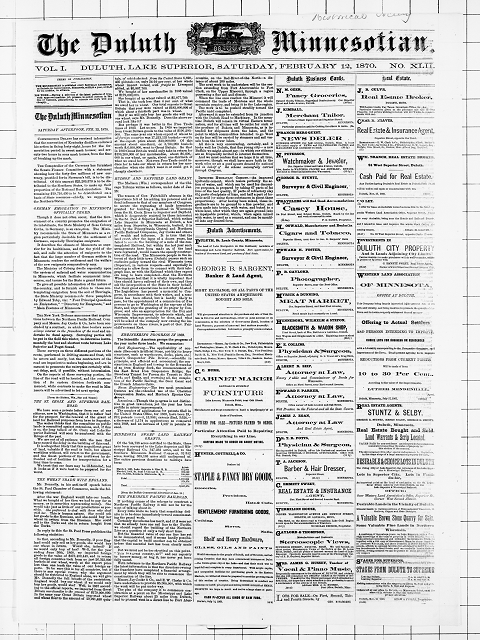Duluth Minnesotian
Duluth Minnesotian (Duluth, Minn.) 1869-1875 Browse the title
Duluth Minnesotian-herald (Duluth, Minn.) 1875-1878 Browse the title
Duluth herald (Duluth, Minn.) 1878 Browse the title
Duluth weekly tribune (Duluth, Minn.) 1871-1890 Browse the title
When it appeared in April 1869, the weekly Duluth Minnesotian became the first newspaper published in Duluth, Minnesota. The paper's founder and editor, Thomas Foster, was previously the editor of the St. Paul Minnesotian and the St. Paul Press, and had moved his newspaper aspirations north in anticipation of a population boom along the shore of Lake Superior. With the expected completion of the Northern Pacific Railway and the Soo Locks in Michigan, Duluth would be a port with access to both the Pacific and Atlantic Oceans, making it twice as profitable in the eyes of investors – particularly Philadelphia financier Jay Cooke. Cooke's support was instrumental in the development of the railway and convinced Thomas Foster that he had made the right decision. In a 1868 speech, Foster called Duluth the "Zenith city of unsalted seas", a nickname that Duluth still claims.

Foster’s high hopes for Duluth were reflected in the pages of the newspaper. Content was boosteristic in nature and focused on the growth of the city. Issues contained accounts of mass immigration to northern Minnesota and how-tos for building the town quickly and expansively. The paper took pride in Duluth's status as "the Chicago of Lake Superior" and bragged about how it would soon overtake the other port cities of the region. The arrival of notable figures to the area was often noted, especially much-needed dentists and surgeons. Other articles include tidbits on how Lake Superior and Duluth got their names, home recipes for pesticide, hair dye, and brandy, and updates on the status of the sidewalks. Contemporary papers described the Duluth Minnesotian as a "spicy little sheet" that "teems with local and railroad items of interest" and "contains much news and information in regard to the Lake Superior country." The four-page issues of Duluth Minnesotian were published weekly on Saturday afternoons, at a cost of $0.10 each or $3 for a year-long subscription.
Thomas Foster's "Editor's Farewell" ran in the Duluth Minnesotian on June 22, 1872. The title of publisher and editor was handed to Thomas Pressnell, who had acted as the business manager of the paper for the previous three years. Pressnell helmed the paper during the financial Panic of 1873, which was one of the worst years in Duluth's history, due to the collapse of Jay Cooke's banks and financial support. The Duluth Minnesotian was fortunate enough to continue operation while many of its competitors closed their doors. In June of 1875, Pressnell passed management of the paper to Edward H. Foster, eldest son of Thomas Foster.
In September 1875 the Duluth Minnesotian merged with its competitor Duluth Weekly Herald to become the Duluth Minnesotian-Herald. The Weekly Herald had begun publication in August 1873 and straggled along through the economic depression for two years before merging with the Minnesotian, which was also still feeling the effects of the recession. Edward Foster remained as publisher, business manager, and local editor, while Judge Edward F. Parker assumed the role of editor-in-chief. This consolidation enabled the Duluth Minnesotian-Herald to increase the number of columns per page from five to seven. Edward Foster's younger brother, Clarence H. Foster, joined as co-publisher in March 1877.
In May 1878, the Minnesotian-Herald was purchased by Robert C. Mitchell, publisher of the Duluth Weekly Tribune. The Weekly Tribune, also published as the Duluth Tribune, had been moved from Superior, Wisconsin to Duluth by Mitchell in May 1870, at the urging of Duluth's mayor and other civic leaders, who were unhappy with unfavorable coverage in the Minnesotian. Mitchell published the Minnesotian-Herald under the masthead Duluth Herald until August 1878, when he merged it into the Weekly Tribune. The consolidated newspaper was published under the title Duluth Tribune and Herald until October 1878, when the name Duluth Weekly Tribune was resumed. The newspaper published under the masthead Duluth Tribune from September 1880 through January 1888.
Mitchell founded a separate daily edition of the Tribune in 1881, the Duluth Daily Tribune. In December 1889 he sold both the weekly and daily titles to a group of investors, including F. J. Chipman of St. Paul, Minnesota, who became the papers' manager. In October 1890, the Duluth Weekly Tribune merged with Lake Superior Mining and Manufacturing Review to form the Lake Superior Review and Weekly Tribune.
In October 1892, the Tribune newspapers were purchased by the rival Duluth News. The daily edition merged with the Duluth Daily News, forming the Duluth News-Tribune, and the weekly edition was renamed the Duluth Weekly News Tribune. As of 2022 the Duluth News-Tribune continues in semiweekly publication.